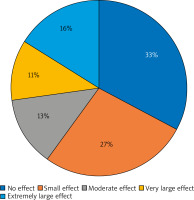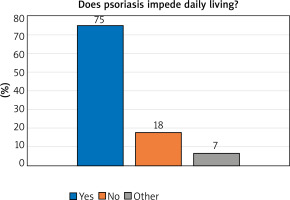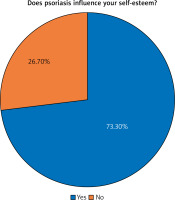Introduction
Psoriasis is a chronic and recurrent inflammatory skin disease with skin or joints manifestations. Skin lesions are characterized mostly by scaling and pruritus [1]. This common dermatosis is a physical and psychological challenge as the visible disfiguration considerably affects self-esteem, which leads to a deterioration in the quality of life [2]. Research showed that among chronic diseases, only depression and chronic lung disease are associated with a worse well-being of patients than psoriasis [3]. Moreover, depression is frequently observed in patients with psoriasis. Scaly patches can appear on any part of the body, however, the most commonly affected areas are knees, elbows and scalp. Psoriasis itself, as well as psoriatic systemic and topical treatments, can lead to alopecia. In some cases, scarring alopecia may develop, resulting in irreversible hair loss [4].
Although there is no cure for psoriasis, there are numerous therapeutic options available, which, when combined, make it possible to achieve and maintain a satisfactory control of the symptoms. First-line treatment for mild and moderate severity of the disease, which applies to the majority of patients, involves topical agents. Keratinolytic substances, such as salicylic acid and urea, remove scale from psoriatic plaque, facilitating the penetration of active ingredients. The mainstay of treatment is topical corticosteroids, preferably combined with vitamin D or A derivatives [5]. In more severe cases, phototherapy and systemic therapy, such as methotrexate or cyclosporine, are needed. Phototherapy, including ultraviolet B (UVB) and A with psoralen (PUVA), can also be used concomitantly with topical vitamin A and D derivatives [5]. Treatment regimens vary depending on patients’ skin type and severity of the symptoms.
Aesthetic dermatology also provides healthcare professionals with tools for targeting patients’ appearance and, consequently, their body image and self-esteem. It is especially crucial for women, who suffer more from stigmatization due to the hard reality of how women are perceived in the society. Research has shown that women with clear skin are perceived as more intelligent and creative, while those with various skin imperfections as boring and introverted [6]. This phenomenon has a huge negative impact on women’s social and emotional lives, makes them more likely to experience loneliness and anxiety, which is a well-known risk factor for the exacerbation of the disease [7].
Aim
One aim of this study is to evaluate patients’ knowledge on professional and at-home care treatments. Another aim is to determine the influence of the disease on the patients’ self-esteem and quality of life. A brief description of different available methods for increasing the efficiency of topical agents from the field of aesthetic dermatology is included in the discussion.
Material and methods
The study was conducted in the Dermatology Clinic of the Heliodor Święcicki Clinical Hospital of the Poznan University of Medical Sciences. Participants were recruited from inpatients admitted to the hospital for treatment of a psoriasis flare-up. The data were gathered using the DLQI questionnaire, personal interview, physical examination and a follow-up survey.
Results
Among the 45 psoriatic patients, 16 were females. The majority of the sample consisted of individuals between 36 and 55 years of age (66.7%), 17.8% were younger than 36 and 15.5% were older than 55. More than half (68.9%) of the respondents did not have any knowledge of the existence of psoriasis before their own diagnosis. The patients most commonly identified the whole surface of the body (32.4%), knees or elbows (22.5%) and scalp (18.3%) as areas currently affected by lesions. The most frequently mentioned risk factors triggering the development of new lesions were stress (47.8%) and poor diet (31.9%).
As shown in Figure 1, the DLQI questionnaire revealed that psoriasis had a very large or extremely large effect on the lives of 27% of the patients.
When asked about specific aspects contributing to the matter of the quality of life, a vast majority (75.5%) of the respondents admitted that psoriasis makes their everyday life and tasks difficult. Three patients added that out of all of the daily situations, meeting new people was the most heavily affected. Distribution of the results is shown in Figure 2.
As shown in Figure 3, when answering the question about the influence of the disease on their self-esteem, 73.3% of the patients acknowledged its strong negative impact. Among the individuals who denied this influence were only 2 women.
Almost all of the patients denied ever receiving aesthetic treatments (86.7%) and only a few of them (17.8%) knew the procedures with a potential to alleviate their symptoms from the field of aesthetic dermatology. However, most of them (66.7%) were able to recall specific skincare products, recommended by their dermatologists for at-home everyday use.
Discussion
Because the aesthetic aspect of managing psoriasis plays an exceptionally important role, it cannot be overlooked. Even a small improvement in the condition of the skin can form a positive breakthrough in a fight for the patients’ self-confidence.
Emollients are crucial for moisturizing, reducing scaling and alleviating pruritus of the lesions. As an adjuvant to conventional therapy, they minimize the risk of skin infection, preventing mechanical injuries from scratching. It has been reported that through hydrating the stratum corneum, emollients enhance the absorption of topical corticosteroids [8]. Moreover, research demonstrates that use of emollients decreases transepidermal water loss in psoriatic patients [9], which is usually high due to lesions characterized by a damaged skin barrier.
Urea, as a natural moisturizing factor of the skin, in low doses also has hydrating properties, however, its effect is dose-dependent. In higher concentrations (> 10%), urea promotes keratinolysis, therefore enhancing the penetration of conventional topical medications [10].
Other keratinolytic substances are α (AHA) and β hydroxy acids (BHA), widely used as chemical peels. As mechanical peeling is contraindicated in patients with psoriasis, AHA and BHA in low concentrations are a safe and effective alternative. They act through diminishing corneocyte cohesion and desquamating the stratum corneum, which prepares the skin for subsequent treatment [11].
The penetration of topically administered active ingredients can easily be enhanced. Needleless mesotherapy is based on the production of a high-frequency electrical current, which increases the permeability of the cell membrane, providing an efficient transport of active substances into the cells in the deep layers of the epidermis [12]. Unlike conventional needle mesotherapy, this method does not cause injuries to the skin, which prevents the Koebner phenomenon.
Another tool useful in supporting therapy is sonophoresis. This method is based on the use of ultrasounds for transdermal drug delivery enhancement. Numerous studies have provided substantial evidence of the effectiveness of sonophoresis, however, its exact mechanism of action is still not fully understood [13]. Apparent and demonstrated advantages of transdermal drug delivery compared to oral drug delivery are the reason for the continuously growing interest in sonophoresis [14].
Carboxytherapy, on the other hand, is a method of a percutaneous administration of carbon dioxide. It results in immediate vasodilatation, inflammation, improvement in tissue perfusion and increasing oxygen pressure. This process promotes the activity of growth factors, which stimulate angiogenesis [15]. As an adjuvant for treating psoriasis, carboxytherapy leads to a decrease in the size, thickness, and quantity of the plaques. Equally important is the fact that this procedure also has the capacity for alleviating pruritus and reducing erythema [16].
The knowledge of the methods of supportive therapy described above can improve the quality of life of patients with psoriasis, which is a key objective of therapy. A negative self-perception puts such patients under considerable stress, which exacerbates the condition of their skin, creating a vicious cycle. To break out of it, many patients may need professional help from a psychologist or a psychiatrist.
Conclusions
Psoriasis is a chronic inflammatory disease, the pathogenesis of which is complex and still not fully understood. Our study showed it is debilitating in many ways, impeding the patients’ social lives, their self-esteem and mental health. Disfiguring skin diseases, such as psoriasis, induce a great amount of psychological suffering, and targeting it needs to be multidisciplinary. Combining the available therapeutic methods to alleviate the symptoms until the cure for psoriasis is discovered should be therefore considered a matter of vital importance.











